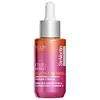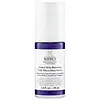What's inside
What's inside
 Key Ingredients
Key Ingredients

 Benefits
Benefits

 Concerns
Concerns

 Ingredients Side-by-side
Ingredients Side-by-side

Water
Skin ConditioningSodium Ascorbyl Phosphate
AntioxidantGlycereth-7 Triacetate
EmollientPentylene Glycol
Skin ConditioningPolysorbate 20
EmulsifyingDipropylene Glycol
HumectantGlycerin
HumectantDimethyl Isosorbide
SolventAscorbyl Glucoside
AntioxidantAscorbic Acid
AntioxidantMalpighia Glabra Fruit Juice
Skin ConditioningRetinol
Skin ConditioningSodium Hyaluronate
HumectantMyristyl Nicotinate
Skin ConditioningTamarindus Indica Seed Polysaccharide
Skin ConditioningOrobanche Rapum Extract
Skin ProtectingMalus Domestica Fruit Cell Culture Extract
Skin ConditioningCamellia Sinensis Leaf Extract
AntimicrobialXylitylglucoside
HumectantBacillus/Sea Salt Ferment Filtrate
Skin ConditioningHydroxymethoxyphenyl Decanone
Skin ConditioningAnhydroxylitol
HumectantAdenosine
Skin ConditioningXylitol
HumectantGlucose
HumectantEthylhexylglycerin
Skin ConditioningLecithin
EmollientXanthan Gum
EmulsifyingAcrylates/C10-30 Alkyl Acrylate Crosspolymer
Emulsion StabilisingPropanediol
SolventMaltodextrin
AbsorbentRhizobian Gum
Mica
Cosmetic ColorantParfum
MaskingLimonene
PerfumingLinalool
PerfumingGeraniol
PerfumingCitral
PerfumingCitronellol
PerfumingBenzyl Benzoate
AntimicrobialChlorphenesin
AntimicrobialPhenoxyethanol
PreservativeBHT
AntioxidantBHA
AntioxidantSodium Benzoate
MaskingPotassium Sorbate
PreservativeCI 77491
Cosmetic ColorantCI 77891
Cosmetic ColorantWater, Sodium Ascorbyl Phosphate, Glycereth-7 Triacetate, Pentylene Glycol, Polysorbate 20, Dipropylene Glycol, Glycerin, Dimethyl Isosorbide, Ascorbyl Glucoside, Ascorbic Acid, Malpighia Glabra Fruit Juice, Retinol, Sodium Hyaluronate, Myristyl Nicotinate, Tamarindus Indica Seed Polysaccharide, Orobanche Rapum Extract, Malus Domestica Fruit Cell Culture Extract, Camellia Sinensis Leaf Extract, Xylitylglucoside, Bacillus/Sea Salt Ferment Filtrate, Hydroxymethoxyphenyl Decanone, Anhydroxylitol, Adenosine, Xylitol, Glucose, Ethylhexylglycerin, Lecithin, Xanthan Gum, Acrylates/C10-30 Alkyl Acrylate Crosspolymer, Propanediol, Maltodextrin, Rhizobian Gum, Mica, Parfum, Limonene, Linalool, Geraniol, Citral, Citronellol, Benzyl Benzoate, Chlorphenesin, Phenoxyethanol, BHT, BHA, Sodium Benzoate, Potassium Sorbate, CI 77491, CI 77891
Water
Skin ConditioningGlycerin
HumectantButylene Glycol
HumectantPentylene Glycol
Skin ConditioningNiacinamide
SmoothingCetyl Alcohol
EmollientIsohexadecane
EmollientIsononyl Isononanoate
EmollientDiisopropyl Sebacate
Emollient2-Oleamido-1,3-Octadecanediol
Skin Conditioning4-T-Butylcyclohexanol
MaskingAcetyl Dipeptide-1 Cetyl Ester
Skin ConditioningAdenosine
Skin ConditioningCeramide NP
Skin ConditioningHydroxypalmitoyl Sphinganine
Skin ConditioningLauroyl Lysine
Skin ConditioningOctyldodecanol
EmollientPentaerythrityl Tetra-Di-T-Butyl Hydroxyhydrocinnamate
AntioxidantSodium Chloride
MaskingSodium Hyaluronate
HumectantSodium Hydroxide
BufferingTrisodium Ethylenediamine Disuccinate
Retinol
Skin ConditioningTocopherol
AntioxidantDicaprylyl Ether
EmollientAmmonium Polyacryloyldimethyl Taurate
Emulsion StabilisingBehenyl Alcohol
EmollientCaprylyl Glycol
EmollientCarbomer
Emulsion StabilisingCetearyl Alcohol
EmollientCetearyl Glucoside
EmulsifyingGlycine Soja Oil
EmollientHelianthus Annuus Seed Oil
EmollientHydroxyethylcellulose
Emulsion StabilisingLecithin
EmollientPhenethyl Alcohol
MaskingPoloxamer 188
EmulsifyingPolycaprolactone
StabilisingSorbitan Laurate
EmulsifyingSteareth-100
Gel FormingCI 40800
Cosmetic ColorantChlorphenesin
AntimicrobialPhenoxyethanol
PreservativeWater, Glycerin, Butylene Glycol, Pentylene Glycol, Niacinamide, Cetyl Alcohol, Isohexadecane, Isononyl Isononanoate, Diisopropyl Sebacate, 2-Oleamido-1,3-Octadecanediol, 4-T-Butylcyclohexanol, Acetyl Dipeptide-1 Cetyl Ester, Adenosine, Ceramide NP, Hydroxypalmitoyl Sphinganine, Lauroyl Lysine, Octyldodecanol, Pentaerythrityl Tetra-Di-T-Butyl Hydroxyhydrocinnamate, Sodium Chloride, Sodium Hyaluronate, Sodium Hydroxide, Trisodium Ethylenediamine Disuccinate, Retinol, Tocopherol, Dicaprylyl Ether, Ammonium Polyacryloyldimethyl Taurate, Behenyl Alcohol, Caprylyl Glycol, Carbomer, Cetearyl Alcohol, Cetearyl Glucoside, Glycine Soja Oil, Helianthus Annuus Seed Oil, Hydroxyethylcellulose, Lecithin, Phenethyl Alcohol, Poloxamer 188, Polycaprolactone, Sorbitan Laurate, Steareth-100, CI 40800, Chlorphenesin, Phenoxyethanol
 Reviews
Reviews

Ingredients Explained
These ingredients are found in both products.
Ingredients higher up in an ingredient list are typically present in a larger amount.
Adenosine is in every living organism. It is one of four components in nucleic acids that helps store our DNA.
Adenosine has many benefits when used. These benefits include hydrating the skin, smoothing skin, and reducing wrinkles. Once applied, adenosine increases collagen production. It also helps with improving firmness and tissue repair.
Studies have found adenosine may also help with wound healing.
In skincare products, Adenosine is usually derived from yeast.
Learn more about AdenosineChlorphenesin is a synthetic preservative. It helps protect a product against bacteria in order to extend shelf life. In most cases, Chlorphenesin is paired with other preservatives such as phenoxyethanol and caprylyl glycol.
Chlorphenesin is a biocide. This means it is able to help fight the microorganisms on our skin. It is also able to fight odor-releasing bacteria.
Chlorphenesin is soluble in both water and glycerin.
Studies show Chlorphenesin is easily absorbed by our skin. You should speak with a skincare professional if you have concerns about using Chlorphenesin.
Learn more about ChlorphenesinGlycerin is already naturally found in your skin. It helps moisturize and protect your skin.
A study from 2016 found glycerin to be more effective as a humectant than AHAs and hyaluronic acid.
As a humectant, it helps the skin stay hydrated by pulling moisture to your skin. The low molecular weight of glycerin allows it to pull moisture into the deeper layers of your skin.
Hydrated skin improves your skin barrier; Your skin barrier helps protect against irritants and bacteria.
Glycerin has also been found to have antimicrobial and antiviral properties. Due to these properties, glycerin is often used in wound and burn treatments.
In cosmetics, glycerin is usually derived from plants such as soybean or palm. However, it can also be sourced from animals, such as tallow or animal fat.
This ingredient is organic, colorless, odorless, and non-toxic.
Glycerin is the name for this ingredient in American English. British English uses Glycerol/Glycerine.
Learn more about GlycerinLecithin is a term for a group of substances found in the cell membranes of plants, animals, and humans. They are made up of mixture of phospholipids.
This ingredient has emollient and emulsifying properties.
As an emollient, lecithen helps soften the skin and creates a barrier to keep moisture in.
As an emulsifier, it also helps prevent water and oil ingredients from separating. Lecithin can also help ingredients be better absorbed by the skin.
This is because the phospholipids in lecithin produce liposomes. Liposomes help other ingredients get through the skin barrier.
Depending on the source of this ingredient, lecithin may not be fungal acne safe. This is because some sources of lecithin come from soybean oil, which may feed the malassezia yeast that feeds fungal acne.
We recommend reaching out to the brand you are purchasing from to inquire about the source of their lecithin.
Some other names for this ingredient include soy lecithin and deoiled soy lecithin.
Learn more about LecithinPentylene glycol is typically used within a product to thicken it. It also adds a smooth, soft, and moisturizing feel to the product. It is naturally found in plants such as sugar beets.
The hydrophilic trait of Pentylene Glycol makes it a humectant. As a humectant, Pentylene Glycol helps draw moisture from the air to your skin. This can help keep your skin hydrated.
This property also makes Pentylene Glycol a great texture enhancer. It can also help thicken or stabilize a product.
Pentylene Glycol also acts as a mild preservative and helps to keep a product microbe-free.
Some people may experience mild eye and skin irritation from Pentylene Glycol. We always recommend speaking with a professional about using this ingredient in your routine.
Pentylene Glycol has a low molecular weight and is part of the 1,2-glycol family.
Learn more about Pentylene GlycolPhenoxyethanol is a preservative that has germicide, antimicrobial, and aromatic properties. Studies show that phenoxyethanol can prevent microbial growth. By itself, it has a scent that is similar to that of a rose.
It's often used in formulations along with Caprylyl Glycol to preserve the shelf life of products.
Retinol is a gold-standard ingredient for anti-aging. It is a form of Vitamin A and belongs to the class of retinoids that also includes tretinoin.
Why is retinol famous?
It has the most scientific studies backing up its skin benefits out of all the non-prescription ingredients.
Retinol is proven to:
This is why retinol is effective at removing wrinkles, fading dark spots, treating acne, and reducing the appearance of pores.
Studies show retinol is less effective when exposed to UV. Be sure to look for appropriate packaging to keep your retinol potent (similar to Vitamin C).
Using retinol or any retinoids will increase sun-sensitivity in the first few months. Though studies show retinoids increase your skin's natural SPF with continuous use, it is best to always wear sunscreen and sun-protection.
We recommend speaking with a medical professional about using this ingredient during pregnancy.
Retinol may cause irritation in some people, so be sure to patch test. Experts recommend 'ramping up' retinol use: start using this ingredient once a week and work up to using it daily.
Read about Tretinoin
Learn more about RetinolSodium Hyaluronate is hyaluronic acid's salt form. It is commonly derived from the sodium salt of hyaluronic acid.
Like hyaluronic acid, it is great at holding water and acts as a humectant. This makes it a great skin hydrating ingredient.
Sodium Hyaluronate is naturally occurring in our bodies and is mostly found in eye fluid and joints.
These are some other common types of Hyaluronic Acid:
Learn more about Sodium HyaluronateWater. It's the most common cosmetic ingredient of all. You'll usually see it at the top of ingredient lists, meaning that it makes up the largest part of the product.
So why is it so popular? Water most often acts as a solvent - this means that it helps dissolve other ingredients into the formulation.
You'll also recognize water as that liquid we all need to stay alive. If you see this, drink a glass of water. Stay hydrated!
Learn more about Water